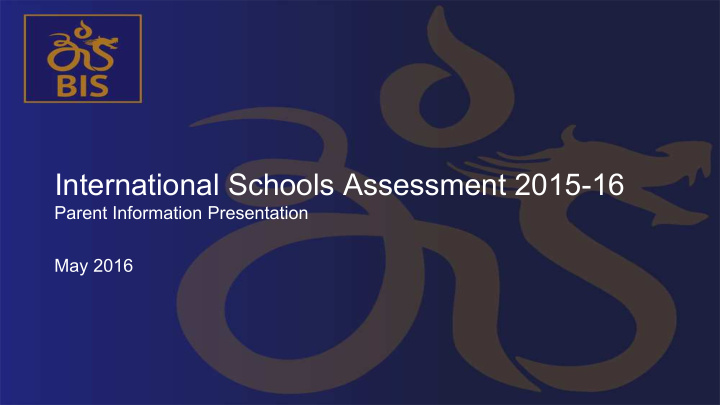



International Schools Assessment 2015-16 Parent Information Presentation May 2016
Characteristics of the Tests: - Chosen because it is in line with BIS’s mission, vision, and student aims - The ISA is not based on any one curriculum but tests core skills in mathematical literacy, reading, writing (narrative and expository.) - An assessment with a broad cultural base (ie. no dollar or pounds) - A combination of multiple-choice and open-ended questions and prompts. The open-ended questions require students to generate meaning, explain their reasoning, find evidence and justify their opinions. - based on the internationally endorsed reading, mathematical literacy and scientific literacy frameworks of the OECD's Programme for International Student Assessment (PISA).
IB (PYP and MYP) and the ISAs The International Baccalaureate (IB) and the Australian Council for Educational Research (ACER) have an informal agreement to communicate about research projects using the ISA that are of mutual interest. In 2009 the IB commissioned ACER to report on how PYP and MYP students performed on the ISA. As a follow up to this study, IB again commissioned ACER to further document student performance on the ISA from 2009-11, as well as to investigate perceptions, attitudes and wellbeing of IB students through student questionnaires. The findings of these studies have been released and the research summaries and reports can be found here. How does the ISA align with the IB curriculum?
Individual Results “In order to make best use of the results, it is important to interpret them in the context of other information about students’ achievement, provided by on-going classroom assessment and perhaps other external assessments.”
Background Statistical Information In February 2015 over 64,000 students from 312 international schools in 78 countries participated in the ISA. The numbers by grade level were 7064 at Grade 3, 5469 at Grade 4, 6992 at Grade 5, 5348 at Grade 6, 5674 at Grade 7, 5433 at Grade 8, 4077 at Grade 9 and 2758 at Grade 10. About 65% of the students were from non-English speaking backgrounds. This percentage is similar to proportion of non-English speaking background students as in the February 2014 administration when the proportion was 67%. In February 2015 more boys than girls took the assessments, with boys comprising between 50% and 53% of each grade level.
Asia 97 • School size: – modal size 201-500 students Europe 71 – range from 10 schools with fewer than 50 students to 1 with over 3000 Africa & Middle 42 East • More than half of schools offer Pre-school to Grade 12 • Curriculum style: Americas 16 – Two thirds use an IB component in their curriculum (108 schools use PYP and/or MYP) – Others predominantly use ‘USA’ or ‘British’, then other national curricula in their description e.g. Canadian, with or without ‘international’.
How are the tests scored? A scale is constructed so that raw score results across different tests can be standardized and then used for comparison (students from year to year, different grades from one year to the next, etc.) The ISA scales are based on those developed for the Programme for International Student Assessment (PISA). The average proficiency of 15 year-old students is set at 500 with a standard deviation of 100.
The ISA scales are also converted for the school into a PISA level in Math and reading. This is the Each of the four ISA scales comparison table for reading. is divided into levels. Each level describes skills that students with scale scores at or above this level typically demonstrate. The levels DO NOT correlate to grade levels.
The Parent Report:
The rubric describing the levels is helpful to see what your child can do now and how s/he can improve.
What does the school do with the data? Copies of the School, Grade Level and Class reports have been given to each teacher, programme coordinator and Principal. Teachers will be meeting to look at the data. In particular, teachers are looking at the questions from the test and determining general areas of strength in our program as well as areas we would like to strengthen. The individual results are being analyzed to see how this data fits with our internal assessment data.
Table of BIS’s results
Thank you!
Recommend
More recommend